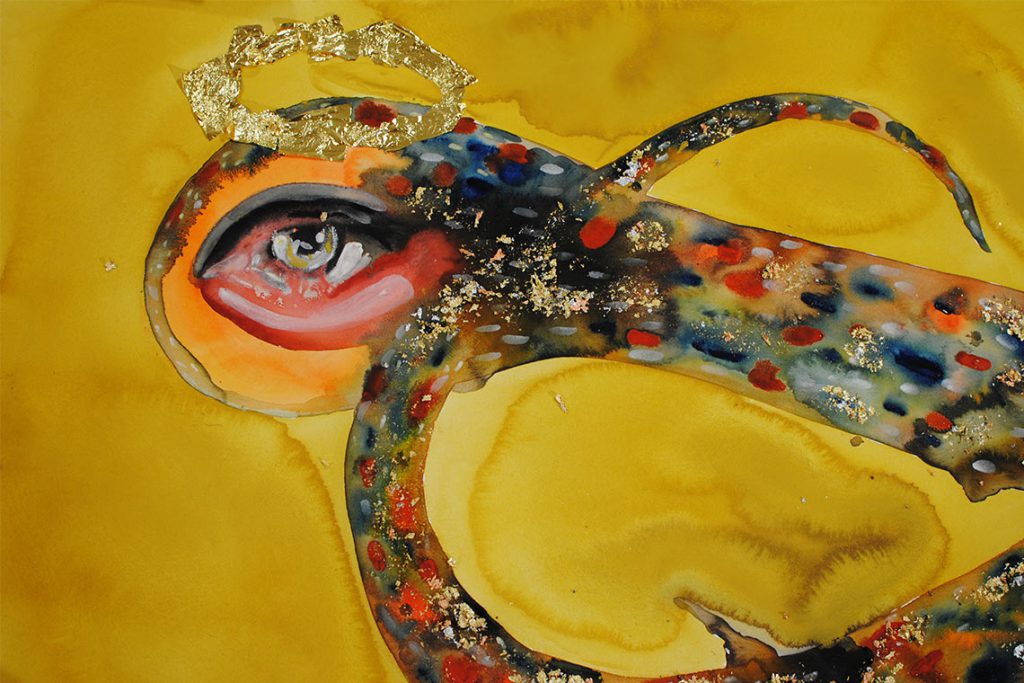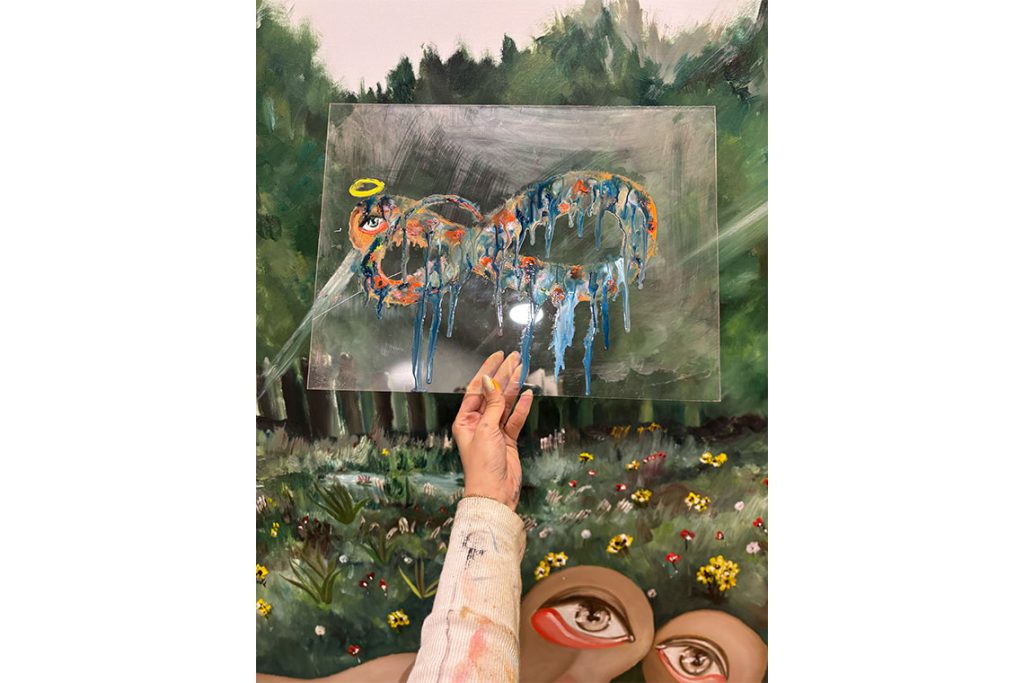For its Year of Serpenti, Bvlgari commissioned the Kuwaiti artist to reinterpret the serpent through her artistic language, one that is defined by a surrealist, painterly embrace of natural and culturally symbolic motifs.
Represented by Dubai-based Tabari Artspace, Rashed has developed an oeuvre centred around identity, regional folklore and the environment, often using the vehicle of the human form, through which she negotiates female subjectivity. Recipient of the Masters Scholarship and the Merit Scholarship from the Kuwait Ministry of Higher Education, she also received a fellowship at the Professional Development Initiative Program (co-sponsored by the Ministry, the National US-Arab Chamber of Commerce, Embassy of Kuwait and the Kuwait Foundation for the Advancement of Sciences). Rashed then went on to achieve an MFA from Parsons School of Design and a BFA from the School of Visual Arts, both in New York. As a result of her cross-cultural experience, the engagement of Eastern and Western perspectives, and the amalgamation of tradition and modernity, Rashed’s practice proves deeply subjective while still possessing universal resonance. Here, she speaks about the process of working with powerful signifiers and translating one of Bvlgari’s best-known emblems in her newest work, Your Endless Glory Shimmers Under My Sun (Your Love Stretches Infinitely Beyond Me).
Canvas: Your work – as well as Bvlgari’s designs – feature iconic motifs, such as eyes and snakes. What draws you to work with such strongly connoted symbols?
Alymamah Rashed: A motif is an invitation to let the viewer access an image, as well as being the first entry point into a story. I utilise symbols as signifiers of a passing object I might have picked up in my everyday life, a fleeting intense sensation, or a self-composed phenomenon orchestrated by natural elements such as a leaf, a mountainscape or a humble pebble. These signifiers tie the eye of the viewer into the composition, making them shift from one access point to another. In other words, they choreograph the viewer’s gaze and allow it to land in the eye of the figure in order to gift the viewer a sense of affinity. Signifiers present in the work I have made for Bvlgari, such as the body of the snake, the dancing scales of its body and its eye, are intended to invite the viewer to flow into the figure’s fluctuant nature as a snake that elongates itself infinitely by floating within and above vast space; the snake becomes a celestial body that transcends reality and lives within a liminal space, somewhere between the seven skies. Signifiers become agents for self-composed mythologies and stories from within.
What does the snake mean to you?
To me, it is a being of fluctuation and elongation, radiating through its shiny scales and vibrant colours to captivate whoever encounters it. In popular culture, we usually hear of snakes being referenced as symbols of deception or manipulation. Yet in Persian mythology, the snake serves as a signifier for fertility, water and wealth. The snake is also one of the oldest signifiers in Arabia for notions of female empowerment and the power of life. It is also a creature of affinity, mutiny and beauty, holding a dynamic nature that befriends the duality of human nature. My snake thrives in its elongation and it is held in time, just for a moment. It is a creature of constant movement, but I want to capture it in time and let it initiate a gaze and a pathway into its spirit and nature.

What is the connection between your artistic practice and Bvlgari’s conceptual universe?
I found the connection point between Bvlgari’s perception of the natural world and mine to unite through the usage of various patterns, textures and colours found within specific creatures such as snakes, peacocks and butterflies. My figures mimic the textures present in a leaf I found in Mountain Lake Forest, in the province of Sakarya in Türkiye, and they also caress a gifted jar filled with dead Kuwaiti spring butterflies collected from Jaber Bridge. In other words, my figures become nature or surround themselves with a self-generated naturescape compiled from my own memory of being in a specific location, such as the mountains, forests and lakes that I have visited during my trips. Bvlgari’s reference to nature is the same. The work of art becomes the natural phenomenon itself or replicates its textures to create a perception of it.
How does cross-disciplinary collaboration challenge, support or impact art-making?
I think it’s absolutely crucial to be able to collaborate with other entities, because you are able to heighten each other’s narratives and essence through storytelling. You are also introducing each other to different media, types of craftsmanship and enhanced perceptions of what a signifier can evoke. I think too that it’s important to be able to heighten the tangibility of your “source”. The source is the seed of the work and the seed blooms differently every time it decides to hold a new connection point established through itself and a new entity. Collaborations such as this are able to heighten one’s own language of creation, allowing for the work to establish a new dialogue and to simply marry two stories into one. It becomes an alignment, rather than a disruption.
What inspired Your Endless Glory Shimmers Under My Sun (Your Love Stretches Infinitely Beyond Me)? Bvlgari’s Year of Serpenti inspired me to celebrate the glory and the beauty of the snake. I wanted to highlight my snake through vivid colours, a vastness of endless space and a bodily loop of infinity. Your Endless Glory Shimmers Under My Sun (Your Love Stretches Infinitely Beyond Me) celebrates the very essence of a snake, beholding its duality, sensuality and brightness.

Tell us about the process of creation and about your choices of material.
The work was made on a large scroll of handmade watercolour paper from France and is created through the fluidity and vibrancy of Japanese watercolours. I wanted the fluidity and freedom of the medium to mimic the nature of the snake. Snakes are patrons and symbols of water in Persian mythology and I wanted to create the snake through water. I also used my entire body to create the image on the panel and I felt like I became the snake itself, immersing my full physical and spiritual presence into the panel of paper. I also highlight part of the snake’s scales with gold leaf, so that its skin catches on to light and shines back at the viewer. Your Endless Glory Shimmers Under My Sun (Your Love Stretches Infinitely Beyond Me) includes a poem on the back. To me, poetry is another signifier of the work. Poetry is play and a language that heightens my spirituality. The snake figure becomes even more present through this added mode of storytelling. The work itself is the skin and the poetry is what’s underneath, it is the soul of the soul, the essence of the essence and the seed of the seed.
Did your perception of snakes, jewellery – or even your own practice – shift or evolve during the course of producing the artwork?
I was very happy to see how the colour palette became extremely vivid in comparison to my current works in the studio. I found Bvlgari’s usage of colour to be vibrant and full of life, perhaps beyond life itself. I wanted to simply paint a snake that is not from Earth, perhaps from the Seven Skies. This decision was immediate and present since we had our first call together. In Your Endless Glory Shimmers Under My Sun (Your Love Stretches Infinitely Beyond Me), Bvlgari heightened a sense of duality within myself and the snake. We became one and it empowered me even more to highlight power, fluidity and beauty through Bvlgari’s Year of Serpenti.
What do you wish to evoke through this work?
I simply want the viewer to embody the snake and become the snake itself. The snake serves the viewer as a mirror, highlighting one’s vivid nature, fluidity and fluctuant growth. The snake invites the viewer to enter its “seed” and to leave with a gift: one’s own power and ability to transcend any barriers within. The snake is a reminder and reflection to hold your essence, to protect its glorious freedom and to caress its abundant beauty.
This interview first appeared in Canvas 116: Time After Time



